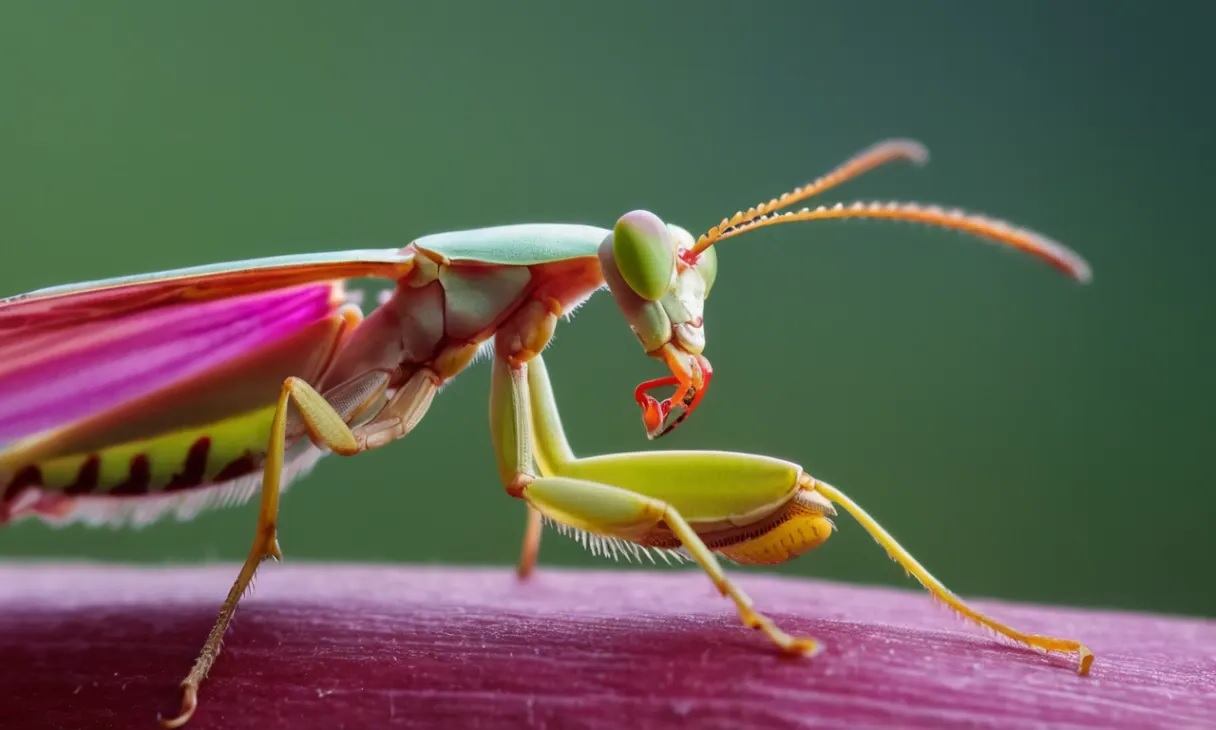
Orchid mantises are some of the most fascinating insects on the planet. Known for their striking resemblance to orchid flowers, these mantises use their unique appearance to blend seamlessly into their surroundings. But what makes them so special? Orchid mantises are not just pretty faces; they are skilled hunters, using their flower-like disguise to ambush unsuspecting prey. They can be found in the rainforests of Southeast Asia, where their vibrant colors and petal-like limbs make them nearly invisible among the flora. These mantises are masters of deception, and their behavior is as intriguing as their appearance. Ready to learn more about these incredible creatures? Let's dive into 33 amazing facts about orchid mantises!
Key Takeaways:
- The Orchid Mantis, a master of disguise, mimics orchid flowers to ambush prey. It has unique behaviors like remaining motionless and cannibalism, and faces threats from habitat loss.
- Orchid Mantises play a crucial role in controlling insect populations and are popular in the pet trade. They continue to captivate scientists and nature enthusiasts with their incredible diversity.
Orchid Mantis: Nature's Master of Disguise
The Orchid Mantis is a fascinating insect known for its incredible camouflage abilities. This mantis species has evolved to mimic the appearance of orchid flowers, making it a master of disguise. Let's dive into some amazing facts about this unique creature.
-
The Orchid Mantis (Hymenopus coronatus) is native to the rainforests of Southeast Asia, particularly Malaysia, Indonesia, and Thailand.
-
Unlike many other mantis species, the Orchid Mantis does not rely on green or brown camouflage. Instead, it mimics the vibrant colors and shapes of orchid flowers.
-
This mantis uses its flower-like appearance to ambush prey. Insects attracted to flowers for nectar often fall victim to the Orchid Mantis.
-
The Orchid Mantis can change its color to match its surroundings, ranging from white to pink or purple, enhancing its camouflage.
-
Females are significantly larger than males, with females growing up to 6 cm long while males are about half that size.
-
The Orchid Mantis has specialized legs that resemble flower petals, adding to its convincing disguise.
-
This species is known for its aggressive hunting style, often taking down prey larger than itself.
-
Despite their delicate appearance, Orchid Mantises are formidable predators, feeding on insects like flies, bees, and butterflies.
-
The Orchid Mantis has a unique way of moving that mimics the swaying of flowers in the wind, making it even harder for predators to spot.
-
These mantises have excellent vision, allowing them to detect and react to prey with lightning speed.
The Life Cycle of the Orchid Mantis
Understanding the life cycle of the Orchid Mantis provides insight into its development and behavior. Here are some intriguing facts about their life stages.
-
Orchid Mantises undergo incomplete metamorphosis, meaning they do not have a pupal stage.
-
Females lay eggs in a frothy mass called an ootheca, which hardens to protect the developing embryos.
-
Nymphs, or baby mantises, hatch from the ootheca and resemble miniature adults but without fully developed wings.
-
Nymphs go through several molts, shedding their exoskeletons as they grow.
-
It takes about 7 molts for a nymph to reach adulthood, a process that can take several months.
-
Adult Orchid Mantises have wings, but females rarely fly due to their larger size.
-
Males, being smaller and more agile, are more likely to fly, especially when searching for mates.
-
The lifespan of an Orchid Mantis is typically around 8 months to a year, depending on environmental conditions.
Unique Behaviors and Adaptations
The Orchid Mantis exhibits several unique behaviors and adaptations that make it a remarkable insect. Let's explore some of these fascinating traits.
-
Orchid Mantises are solitary creatures, often found alone except during mating season.
-
They are known for their "deimatic display," where they spread their forelegs and wings to appear larger and more intimidating to predators.
-
This species has a highly developed sense of touch, which helps them detect vibrations and movements of potential prey.
-
Orchid Mantises can remain motionless for long periods, waiting patiently for prey to come within striking distance.
-
They use their powerful front legs to snatch and hold onto prey, often consuming it head-first.
-
The Orchid Mantis has a specialized mouthpart called a "mandible," which is used to chew and consume prey.
-
These mantises are known to be cannibalistic, with females sometimes eating males after mating.
Conservation and Human Interaction
The Orchid Mantis, like many other species, faces challenges in the wild. Here are some facts about their conservation status and interaction with humans.
-
Habitat loss due to deforestation is a significant threat to the Orchid Mantis population.
-
Despite this, they are not currently listed as endangered, thanks to their adaptability and wide distribution.
-
Orchid Mantises are popular in the pet trade, with enthusiasts drawn to their striking appearance and fascinating behavior.
-
Captive breeding programs help reduce the impact on wild populations by providing an alternative source for pet mantises.
-
These mantises play a crucial role in their ecosystems by controlling insect populations.
-
Researchers study Orchid Mantises to understand more about camouflage, predator-prey interactions, and insect behavior.
-
In some cultures, mantises are considered symbols of patience and precision due to their hunting style.
-
The Orchid Mantis continues to captivate scientists and nature enthusiasts alike, showcasing the incredible diversity and adaptability of the insect world.
The Orchid Mantis: Nature's Masterpiece
The Orchid Mantis is a fascinating creature. Its ability to mimic flowers for hunting and protection is truly remarkable. This insect's unique camouflage not only helps it catch prey but also keeps it safe from predators. Found mainly in Southeast Asia, the Orchid Mantis thrives in warm, humid environments.
Their diet consists mainly of other insects, making them effective pest controllers. Despite their delicate appearance, these mantises are fierce hunters. They use their flower-like appearance to lure unsuspecting prey, striking with lightning speed.
Understanding the Orchid Mantis gives us a glimpse into the wonders of evolution and adaptation. These insects remind us of nature's incredible creativity and resilience. If you ever get the chance to observe one, take a moment to appreciate its beauty and ingenuity. The Orchid Mantis truly is a masterpiece of nature.
Frequently Asked Questions
Was this page helpful?
Our commitment to delivering trustworthy and engaging content is at the heart of what we do. Each fact on our site is contributed by real users like you, bringing a wealth of diverse insights and information. To ensure the highest standards of accuracy and reliability, our dedicated editors meticulously review each submission. This process guarantees that the facts we share are not only fascinating but also credible. Trust in our commitment to quality and authenticity as you explore and learn with us.


